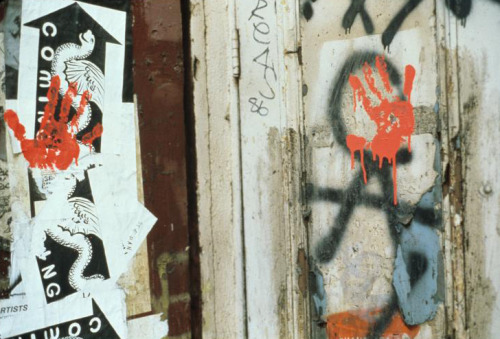unhistorical:Gran Fury was an artistic collective active in New York between 1988 to 1995 that opera
unhistorical:Gran Fury was an artistic collective active in New York between 1988 to 1995 that operated in tandem with ACT UP, the AIDS advocacy group founded in the city in 1987. The organizations’ graphical material, in particular its iconic SILENCE=DEATH design, eventually disseminated beyond the city and beyond activist circles into national discourse and popular culture. Named for a line of Plymouth cars used by the police department, Gran Fury’s tactics embraced advertising techniques - bold aesthetics and graphic design, the exploitation of public spaces, emphasis on wide distribution. At the same time, its members remained wary of the branding of its art as trendy “convenient product” and consistently emphasized the limitations of art and importance of direct action, exemplified by the recurring slogan “Art is not enough”.Our first projects were poster sniping (illegal wheat-pasting of posters on vacant signage), and Xeroxed flyers, a working method which grew out of an ACT UP aesthetic and our limited funds. After about a year, our tactics changed as we questioned whether postering was the most effective means of reaching a large general audience. As Gran Fury received increasing art world support, we did so with the condition that we receive the greatest possible public access to our work, in most cases exhibiting outside the art space itself. We decided not to produce work for the gallery market. Art institutions provided us with access to public spaces a group such as ours would otherwise never have had the resources to acquire; they profited through supporting AIDS work by an activist group which met their aesthetic standards and which was willing to observe certain boundaries of wheat was and was not allowable-explicit obscenity or critique of their sponsors.…At the same time, our work began to feel like a signature style, a convenient product for the art world to use to fulfill its’ desire to “do something” about the AIDS crisis. Gran Fury’s status as flavor of the month in the American art world was over; interest in our work had shifted to Europe where we consistently felt handicapped by attempting to understand their specific issues, as well as by our inability to use colloquial slogans. In 1992 we designed a campaign for Montreal which utilized the symbols of Quebecois sovereignty to draw attention to AIDS issues – specifically a warning to conduct research and design programs that would apply to the Canadian situation. The project backfired because the icon we chose to use was too potent – some did not recognize it as an AIDS campaign. In general, we found that we could only produce the most general messages, otherwise we ran the risk of misreading a local situation or creating something that would fail in translation.Good Luck…Miss You ~ Gran FuryWe want the art world to recognize that collective direct action will bring an end to the AIDS crisis. And that collective direct action can mean a whole lot of things across a whole lot of communities: we have already been co-opted, we are complicit with the art world’s institutions in what we hope are strategic ways. We do not only act as an irritant, we also point to what’s going on in society at large. Whenever we can, we steer the art world projects into public spaces so that we can address audiences other than museum-going audiences or the readership of art magazines…Our main beat isn’t with the art world, it’s with the United States government’s lack of response and the political crisis that underlies the medical crisis of AIDS. If we can use the art world as a tool to broadly articulate concerns, then we are glad for that support. My fear is that the heavy emphasis on the cultural analysis of AIDS distances us from the fact that this is a living, breathing crisis in which lives are at stake right at this moment.BOMB: Gran Fury by Robert GoberNYPL -- source link
Tumblr Blog : unhistorical.tumblr.com







